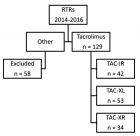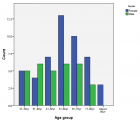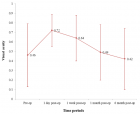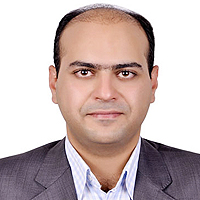Previous Issue (Volume - 9 | Issue - 2)
Difference in Injury Risk between Male and Female Alpine Skiers: Review of the Literature
Published on: 3rd April, 2024
Alpine skiing is popular at varying levels of competitiveness with many skiers participating recreationally and elite skiers competing in downhill, super-G, giant slalom, slalom, and combined events in the World Cup and in the Winter Olympic Games. The rate of injury in alpine skiing is high both recreationally and competitively and methods to reduce injury rates are needed. Additionally, it is well-established in other sports that the risk of injury for an athlete varies based on gender. The purpose of this review is to determine how injury risk differs for each gender of alpine skier. Injury rates vary throughout the literature but point towards males being at a higher risk for overall injury and upper body injuries while females are at a higher risk for knee injuries. Even the specific knee injuries for which each gender is at risk varies with medial collateral ligament (MCL) injuries more common in males and anterior cruciate ligament (ACL) injuries more common in females. More studies are needed to confirm the differences in injury risks and how these risks may differ across levels of competition, thus allowing regulations and injury prevention methods that may be tailored specifically to the injuries an alpine skier is most susceptible to.
The Comparison of Brachial Artery Parameters between the Clinical Cuff, Pneumatic Controlled Air Band (KAATSU), and Elastic Band during Blood Flow Restriction at the same Perceived Tightness
Published on: 30th April, 2024
The Blood Flow Restriction (BFR) technique is based on cuffs connected to a pressure device that induces partial arterial inflow. BFR combined with exercise has already been proven to increase strength, muscle mass, and muscular endurance. However, some BFR devices with pneumatic air bands, such as KAATSU (KA), are expensive and less accessible, making either a Sphygmomanometer Cuff (SC) or Elastic Band (EB) an interesting alternative. However, vascular parameters in response to blood flow restriction during KA, EB, and SC have not yet been compared. Purpose: The aim of this study was to compare the brachial blood flow behavior during restriction using bands such as KA, SC, and EB on the same perceived tightness. Methods: Thirty healthy men participated in a prospective crossover study. Participants underwent blood flow measurements before and during KA, SC, and EB use, with KA-perceived tightness taken as a reference. The brachial blood flow volume, the diameter of the artery, and blood flow velocity were measured before and immediately after the cuff’s inflation at a specific tightness. Results: Blood flow volume was significantly reduced in KA (52%, ES: 1.38), SC (61.7%, ES: 1.29), and EB (41.5%, ES: 1.22) (p
Effects of Physiotherapy Care in the Postoperative of Total Hip Arthroplasty: An Integrative Review
Published on: 11th June, 2024
Introduction: Total hip arthroplasty is a procedure widely performed in orthopedics, as it is capable of restoring function in the hips, severely affected by orthopedic diseases, such as osteoarthritis and consequently reducing pain and restoring function. Objective: To identify the effects of physical therapy in the postoperative period of total hip arthroplasty. Method: This is an integrative review, of an exploratory and descriptive nature, carried out between January and May 2024 and guided by the recommendations of the Joanna Brigs Institute. The Pubmed, LILACS, and SciELO databases were used. The following descriptors were used for the search procedure: “Physiotherapy and hip arthroplasty”. For the operationalization of the search, the Boolean descriptor “AND” was used to cross the descriptors. Articles were included in randomized clinical trials, published in full, without restriction of language and/or year of publication, which dealt with the theme addressed and that responded to the objective of the study. On the other hand, editorial letters, any type of literature review, articles unavailable at the time of search, abstracts and/or full articles published in annals of scientific events, preprints, and articles without abstracts were excluded. Results: After searches in the databases, 108 articles were identified on the platforms, subsequently, all had their titles and abstracts read, then 58 articles were excluded for not meeting the eligibility criteria, leaving 50 articles carefully read in full, after complete reading, only 7 articles composed the final sample. Final considerations: based on the reading and analysis of the articles that were previously selected, it was observed that there is no pre-established protocol among the authors for the postoperative period of hip arthroplasty, but that physical therapy techniques associated with therapist support and an early start are responsible for improving functionality, quality of life, pain reduction and increased muscle strength.
Exploring Dermatofunctional Perspectives beyond Aesthetics: An Integrative Literature Review
Published on: 21st June, 2024
Introduction: Dermatofunctional Physiotherapy is an area of physiotherapeutic specialty that aims to promote, prevent, and treat integumentary injuries. However, this field of action is usually erroneously limited to aesthetic and cosmetic procedures. However, the scope of Physical Therapy goes beyond aesthetic procedures. Objective: To identify the scope of dermatofunctional physiotherapy beyond aesthetics. Methodology: This is an integrative literature review with the objective of summarizing and exploring the proposed theme. For this, the PRISMA guidelines were used, as well as the PICOT strategy for a better delineation of the research question and research theme. Results and discussions: It was observed that the role of the physiotherapist in this field is directly related to aesthetics, which is one of the most prosperous segments within the health area, due to the great demand for aesthetic procedures. Among the main resources evidenced in this study, lymphatic drainage, electrothermophototherapeutic resources, myofascial release, and manual techniques were observed. Final considerations: The area of physical therapy is not exclusively dedicated to the aesthetic environment, it was observed that this specialty acts strongly in the promotion, and prevention of rehabilitation of patients with metabolic, integumentary, and musculoskeletal alterations, in addition to promoting and preventing diseases related to obesity, scars, geloid edema, flaccidity, and other integumentary dysfunctions.
Effects of Physical Therapy in The Postoperative Period of Plastic Surgery: An Integrative Review
Published on: 21st June, 2024
Introduction: The practice of plastic surgery began in the field of reconstructive surgery, in an attempt to recover the functionality of some area of the body or give it a more natural appearance. In this sense, the role of the physical therapist is recommended in various aesthetic surgeries that, through physical therapy resources and techniques, promote tissue healing, reduce the appearance of adhesions, and reduce or eliminate pain, bruises, and edema. Objective: to identify the effects of physical therapy in the postoperative period of plastic surgery. Methodology: This is an integrative literature review, in which there will be a review of articles related to the study of the effects of physical therapy assistance applied to the postoperative period of plastic surgery. Articles related to the proposed theme were included, published between 2011 and 2024, available in full, without language restriction; in addition to theses, dissertations, and monographs. Exclusion criteria were literature review articles, articles or abstracts that had been published in conference proceedings; as well as letters from editors and preprints. Results and discussions: it can show that physiotherapy in the postoperative period of plastic surgery is essential in reducing recovery time, reducing edema, improving the healing process, and preventing the risk of complications in the postoperative period. The main physiotherapeutic resources and techniques were: lymphatic drainage, ultrasound, radiofrequency, laser, and high frequency. Regarding plastic surgeries, the most frequent in the literature were: abdominoplasty, blepharoplasty, rhytidectomy, and liposuction. Final considerations: Dermatofunctional physiotherapy is of paramount importance in the postoperative period of plastic surgery. It is essential in reducing recovery time and reducing the risks arising from surgery.

HSPI: We're glad you're here. Please click "create a new Query" if you are a new visitor to our website and need further information from us.
If you are already a member of our network and need to keep track of any developments regarding a question you have already submitted, click "take me to my Query."






















































































































































